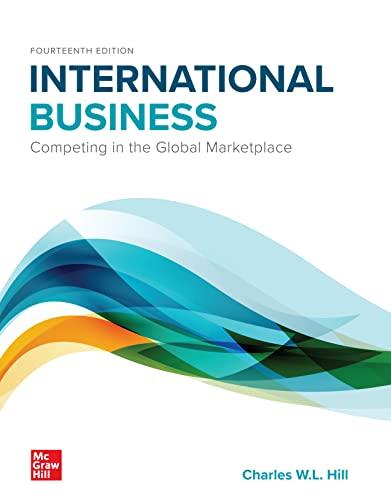IBM has long been one of the worlds foremost information technology enterprises, with a storied history of
Question:
IBM has long been one of the world’s foremost information technology enterprises, with a storied history of making information processing hardware and software and building a world-class business in information technology consulting services. More recently, the company has pushed hard into the cloud computing business, with ambitions to be a major provider of hybrid cloud services to corporations around the world.
When IBM first started to expand internationally after World War II, it did so in the classic “international” pattern of many enterprises, undertaking most of its activities at home and selling its products internationally through overseas sales offices. By the 1970s, however, the company had already moved away from this model and was, by then, a stereotypical “multinational” enterprise, with mini IBMs in major national markets around the world. Each of these mini IBMs was semi-autonomous and focused on local clients. This structure made sense for IBM in the 1970s, given that many markets were still segmented from each other by high barriers to cross-border trade and given that national differences in business practices often required considerable localization of products and services.
In the 1990s and early 2000s, however, IBM moved away from this model and toward one that has been characterized as a “globally integrated enterprise.” In the words of one former CEO: “We are locating work and operations anywhere in the world based on economics, expertise, and the right business environment. We are integrating those operations horizontally and globally.
We used to have separate supply chains in different markets.
Now we have one supply chain, a global one. Our R&D has been global for many years, with research and software development carried out in labs around the world. But in our professional services businesses, where we used to think about our human capital—our people—in terms of countries, and regions, and business units, we now manage and deploy them as one global asset.”
Thus today’s IBM locates its semiconductor R&D and manufacturing operation in upstate New York and Vermont, and its global procurement center is in China.
Global services delivery is in India, while many of the services that support IBM’s external and internal websites are in places such as Ireland and Brazil. The people at each of these centers are not focused on their national markets; they are leading integrated global operations.
This strategic shift was a response to three things; the globalization of the world economy, the global nature of many of IBM’s customers, who were themselves shifting toward a global integration strategy, and the emergence of fierce competition from enterprises in emerging markets such as China and India. Take India as an example; In the 1990s, a trio of Indian outsourcing firms—Tata Consulting Services, Infosys, and Wipro—started to take market share away from IBM in its core information technology services business. The Indians enjoyed an advantage based on a large supply of highly educated but relatively inexpensive engineering and managerial talent. IBM felt that, to compete, it had to adopt the low-cost model being pioneered in India. So, in 2004, it bought Daksh, an Indian firm that was a smaller version of India’s big three information technology services firms. IBM has invested heavily in its Indian unit, building it into a large global business with leading market share that now competes effectively on cost and quality against its Indian rivals.
While the original motivation for expanding in India was to gain access to low-cost labor, IBM now sees the high skill base in India as just as important, if not more so.
IBM can find a large supply of highly skilled people in India who can staff its global services operations and move seamlessly around the world. It doesn’t hurt that most people from India have a good command of the English language, which has become the de facto language of business in much of the world.
IBM is still on its journey to becoming a fully integrated global enterprise. A major thrust of the business has been on developing its human capital—helping to produce managers and engineers who see themselves as global professionals and global citizens, able to move effortlessly around the world and do business effectively in a wide range of national contexts, whatever their national origin. Perhaps the clearest sign of how far this has progressed occurred in early 2020 when Arvind Krishna, who is from the state of Andhra Pradesh in India, became CEO of IBM, the first person not of American origin to hold this position.
Case Discussion Questions 1. Why do you think IBM originally set up “mini IBMs” in major national markets around the world?
2. Why did IBM shift strategy to become a “globally integrated enterprise” in the 1990s and early 2000s?
3. What does the shift in strategy imply for human resource management at IBM? What kind of staffing policy do you think IBM operated under the 1970s? What kind of staffing policy does it have today? How do you think its management development policies have changed over time?
Step by Step Answer:

International Business Competing In The Global Marketplace
ISBN: 9781260387544
14th Edition
Authors: Charles Hill





